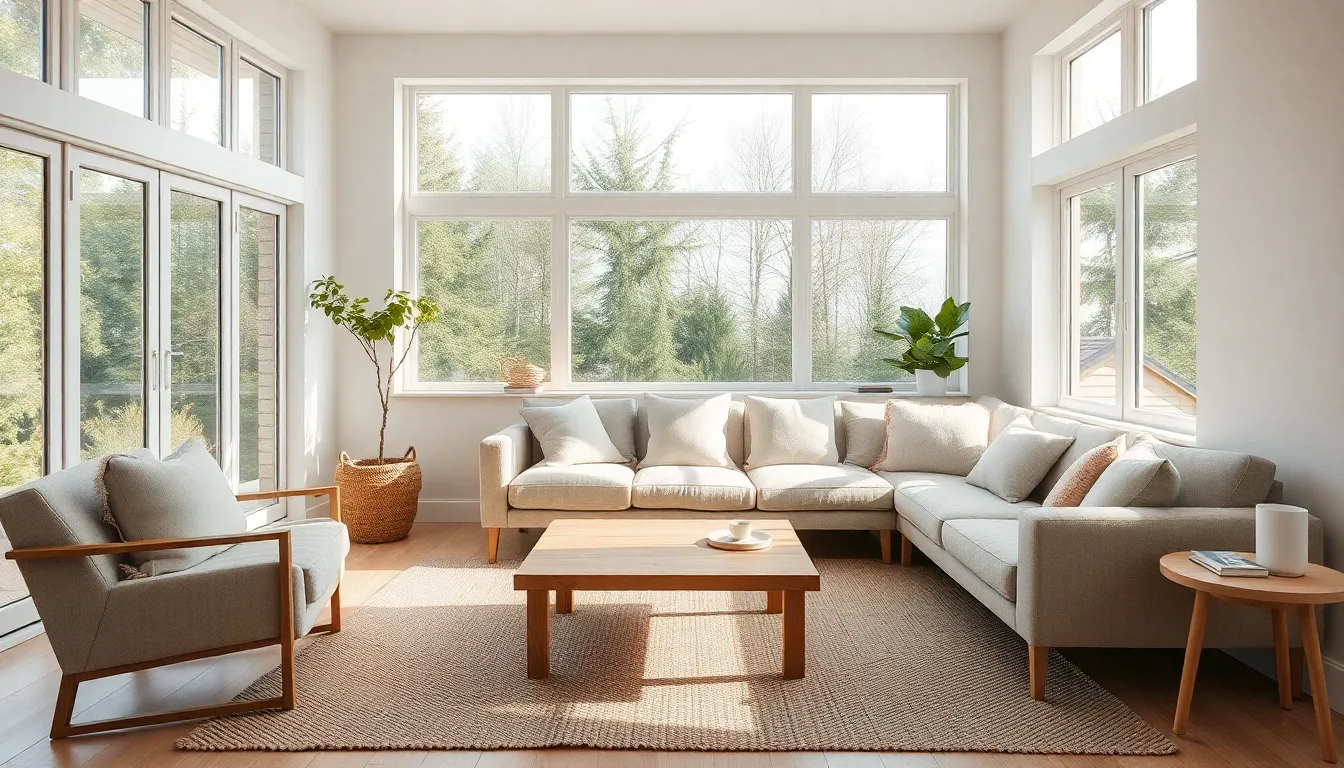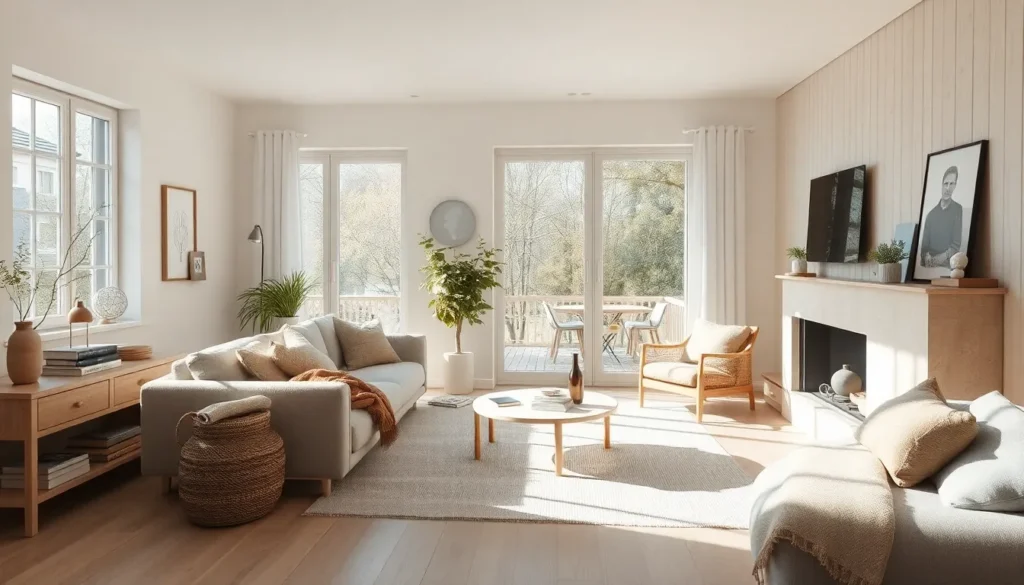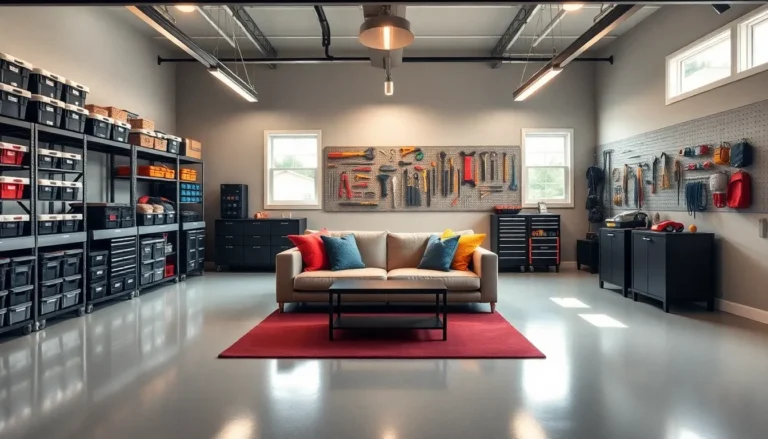Table of Contents
ToggleScandinavian design isn’t just a trend; it’s a lifestyle that whispers elegance while shouting practicality. Imagine stepping into a space where minimalism reigns supreme and every piece of furniture feels like it’s been handpicked by a stylish Viking. With its clean lines and functional beauty, this design philosophy transforms ordinary homes into serene sanctuaries.
But don’t let the simplicity fool you. Scandinavian design packs a punch with its clever use of natural materials and a cozy vibe that invites you to kick off your shoes and stay awhile. It’s the perfect blend of form and function that makes even the most chaotic lives feel effortlessly chic. Dive into the world of Scandinavian design and discover how it can elevate your space while keeping your sanity intact. Who knew that less really could be more?
Overview Of Scandinavian Design
Scandinavian design embodies a harmonious blend of functionality and aesthetics. Known for minimalism, this approach prioritizes simplicity, where clean lines dominate furniture and decor. It utilizes a palette of neutral tones, creating an atmosphere that feels both serene and sophisticated.
Natural materials play a pivotal role in Scandinavian design. Wood, especially light varieties like birch and pine, is often used to bring warmth into spaces. Textiles, such as wool and linen, enhance comfort, inviting individuals to relax in their surroundings.
This design philosophy thrives on creating balance. Whether through the strategic placement of furnishings or the selection of decor elements, each choice reflects an intention to merge form and function. The emphasis on practicality does not compromise style; instead, it elevates living experiences.
Moreover, Scandinavian design promotes a clutter-free environment. By opting for multi-functional furniture, like storage ottomans and minimalist shelving, spaces remain organized and visually appealing. Each element contributes to a cohesive aesthetic, fostering a calm atmosphere.
Lighting also holds significance in this design style. Natural light is maximized through large windows, while simple yet elegant fixtures enhance ambiance during darker months. The focus on illumination underlines the importance of creating inviting spaces.
Scandinavian design transforms homes into tranquil retreats. It achieves this through an unwavering commitment to simplicity, functionality, and the clever use of materials. By prioritizing comfort and aesthetic harmony, it establishes a lifestyle that offers both beauty and serenity.
Key Characteristics

Scandinavian design showcases a collection of distinctive features that create its signature style. These elements work together to establish an inviting and functional aesthetic.
Minimalism
Minimalism defines Scandinavian design by emphasizing simplicity and minimal ornamentation. Clean lines dominate furniture and architecture, which cultivates a sense of openness. Every design choice reflects the philosophy of “less is more.” This approach removes unnecessary clutter, promoting a peaceful environment. Simplified color palettes, often featuring whites and soft pastels, contribute to a serene atmosphere. Decorations prioritize quality over quantity, ensuring each piece has meaning and purpose.
Functionality
Functionality serves as a cornerstone of Scandinavian design. Designers prioritize creating spaces that are usable and practical for everyday life, which often leads to multi-functional furniture. Versatile pieces, such as storage ottomans and extendable tables, maximize space efficiency. The layouts focus on ensuring comfort and easy movement within a room. In addition, thoughtful placements of furniture foster social interaction, creating welcoming spaces. This dedication to utility enhances the overall experience of living and working in these thoughtfully designed environments.
Natural Materials
Natural materials play a vital role in Scandinavian design. Wood, particularly birch and pine, forms the foundation of many furnishings and architectural elements. Their warm tones evoke a cozy ambiance, connecting interiors with nature. Textiles such as wool and linen add texture, while also serving functional purposes like insulation. Designers aim to reflect the Nordic landscape, ensuring a harmonious blend between indoor and outdoor spaces. Sustainably sourced materials underpin the design ethos, showcasing a commitment to environmental responsibility.
Historical Context
Scandinavian design’s roots extend deep into the culture and lifestyle of Northern Europe. It reflects aspects of nature, functionality, and simplicity, originating from unique regional influences.
Origins and Influences
Scandinavian design emerged in the early 20th century, drawing inspiration from traditional Nordic craftsmanship. Folk art played a significant role, with artisans emphasizing practicality and aesthetics in everyday items. Influences from the Bauhaus movement introduced new ideas about minimalism, simplicity, and functional beauty. Nature’s elements shaped the design philosophy, emphasizing harmony with the surrounding environment. The focus on materials like wood and textiles provided a cozy and inviting atmosphere, becoming essential characteristics of this aesthetic.
Evolution Over the Decades
During the 1950s and 1960s, Scandinavian design experienced global recognition, coinciding with a rise in modernism. Designers like Hans Wegner and Alvar Aalto popularized iconic furniture pieces, blending form and function effortlessly. The 1970s saw a shift toward sustainable practices, as environmental consciousness influenced design choices. In recent years, the trend has embraced technology, integrating contemporary materials while maintaining traditional values. Evolution continues, as designers innovate, exploring new ways to enhance functionality and aesthetic appeal while preserving the core principles of Scandinavian design.
Major Designers and Brands
Scandinavian design boasts numerous influential figures and renowned companies that shape its identity today. These designers and brands are pivotal in promoting the principles of simplicity, functionality, and connection to nature.
Iconic Figures
Hans Wegner stands out as an iconic designer known for his chairs that blend beauty with comfort. Arne Jacobsen, another prominent figure, created the famous Egg chair, which showcases innovative shapes and forms. Alvar Aalto’s work reflects a harmonious balance of architecture and furniture design, promoting organic materials. Greta Magnusson Grossman made her mark with modernist designs that emphasize both function and aesthetic appeal. These designers significantly contributed to the Scandinavian design movement, establishing a legacy celebrated for its elegance and practicality.
Notable Companies
IKEA revolutionized Scandinavian design with its affordable, stylish products that emphasize functionality. HAY, another influential brand, focuses on contemporary design while staying true to traditional aesthetics. Muuto showcases innovative designs that reimagine classic Scandinavian styles through fresh perspectives. Bang & Olufsen excels in combining audio technology with stunning design, enhancing functional beauty. Each company plays a crucial role in promoting the principles of Scandinavian design globally, making it accessible and appealing.
The Impact of Scandinavian Design Today
Scandinavian design significantly influences contemporary aesthetics, shaping lifestyle choices around the globe. Its emphasis on minimalism, functionality, and natural materials resonates widely with individuals seeking simplicity.
Global Influence
The global influence of Scandinavian design reflects in diverse markets and cultures. Many designers integrate Scandinavian principles into their work, embracing minimalism in urban settings. Brands ranging from furniture outlets to fashion labels adopt these aesthetics, often prioritizing functionality and environmental consciousness. International events such as design fairs showcase Scandinavian styles, inspiring creatives worldwide. An example includes the rise of open-concept living spaces that promote social interaction, a hallmark of this design ethos. Cities like New York and Tokyo now feature Scandinavian-inspired cafes and boutiques, reinforcing its widespread appeal.
Sustainability in Design
Sustainability serves as a central tenet of Scandinavian design, influencing both practices and consumer choices. Designers prioritize eco-friendly materials and methods, making conscious efforts to minimize environmental impact. This commitment leads to furniture made from responsibly sourced woods and sustainable textiles, enhancing the concept of beauty without compromising the planet. Moreover, brands like IKEA champion recycling and repurposing, providing affordable solutions for sustainability-minded consumers. Innovative designs focus on durability and timelessness, which encourage long-term use rather than disposability. As environmentally responsible practices gain traction globally, Scandinavian design continues to lead the way in harmonizing style with ecological awareness.
Scandinavian design stands as a testament to the beauty of simplicity and functionality. Its ability to blend aesthetics with practicality creates spaces that invite comfort and tranquility. By emphasizing natural materials and sustainable practices, this design philosophy not only enhances living environments but also nurtures a deeper connection with nature.
The influence of iconic designers and brands continues to shape contemporary aesthetics, making Scandinavian design a global phenomenon. As it evolves, the core principles of minimalism and eco-consciousness remain central, appealing to those who value both style and sustainability. Embracing Scandinavian design means embracing a lifestyle that prioritizes harmony, elegance, and a commitment to the environment.








